
A Christmas tree is one of the most popular traditions associated with the celebration of Christmas. It is normally an evergreen coniferous tree that is brought into a home or used in the open, and is decorated with Christmas lights and colourful ornaments during the days around Christmas.
Contents |
Dates
Traditionally, Christmas trees were not brought in and decorated until Christmas Eve (24 December), and then removed the day after twelfth night (i.e., 6 January); to have a tree up before or after these dates was even considered bad luck. Modern commercialisation of Christmas has however resulted in trees being put up much earlier; in shops often as early as late October (in the UK, Selfridge's Christmas department is up by early September, complete with Christmas trees). A common tradition in U.S. homes is to put the tree up right after Thanksgiving (the fourth Thursday in November) and to take it down right after the New Year. However, some households in the U.S. do not put up the tree until the second week of December, and leave it up until the 6th of January. In Germany, Catholics take their Christmas trees down by the 2nd of February.
Types of Christmas trees used

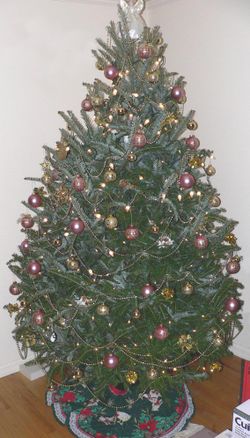
Both natural and artificial trees are used as Christmas trees.
Natural Christmas trees
The best species for use are species of fir (Abies), which have the major benefit of not shedding the needles when they dry out, as well as good foliage colour and scent; but species in other genera are also used. Commonly used species in northern Europe are:
- Silver Fir Abies alba (the original species)
Nordmann Fir Abies nordmanniana (as in the photo)
Noble Fir Abies procera
Norway Spruce Picea abies (generally the cheapest)
Serbian Spruce Picea omorika
Scots Pine Pinus sylvestris
and in North America:
- Balsam Fir Abies balsamea
Fraser Fir Abies fraseri
Grand Fir Abies grandis
Noble Fir Abies procera
Red Fir Abies magnifica
Douglas-fir Pseudotsuga menziesii
Scots Pine Pinus sylvestris
Stone Pine Pinus pinea (as small table-top trees)
Several other species are used to a lesser extent. Less-traditional conifers are sometimes used, such as Giant Sequoia, Leyland Cypress and Eastern Juniper. Blue spruce can also be used as a Christmas tree, but has very sharp needles, making decorating uncomfortable. Virginia Pine is still available on some tree farms in the southeastern United States, however its winter colour is faded. The long-needled Eastern White Pine is also used there. Norfolk Island pine is sometimes used, particularly in the Oceania region, and in Australia some species of the genera Casuarina and Allocasuarina are also occasionally used as Christmas trees.
Some trees are sold live with roots and soil, often from a nursery, to be planted later outdoors and enjoyed (and often decorated) for years or decades. However, the combination of root loss on digging, and the indoor environment of high temperature and low humidity is very detrimental to the tree's health, and the survival rate of these trees is low. These trees must be kept inside only for a few days, as the warmth will bring them out of dormancy, leaving them little protection when put back outside into the midwinter cold in most areas. Others are produced in a container and sometimes as topiary for a porch or patio.
European tradition prefers the open aspect of naturally-grown, unsheared trees, while in North America (outside western areas where trees are often wild-harvested on public lands [1]) there is a preference for close-sheared trees with denser foliage, but less space to hang decorations. The shearing also damages the highly attractive natural symmetry of unsheared trees. In the past, Christmas trees were often harvested from wild forests, but now almost all are commercially grown on tree farms.
Almost all Christmas trees in the United States are grown on Christmas tree farms where they are cut after about ten years of growth and new trees planted. According to the United States Department of Agriculture (USDA) agriculture census for 2002 (the census is done every five years) there were 21,904 farms were producing conifers for the cut Christmas Tree market in America, 446,996 acres were planted in Christmas Trees, and 13,849 farms harvested cut trees. The top 5 percent of the farms (100 acres or more) sold 61 percent of the trees. The top 26 percent of the farms (20 acres or more) sold 84 percent of the trees. 21% of the farms were less than two acres and sold an average of 115 trees per farm. [2]
In the UK, The British Christmas Tree Growers Association represents the interests of all those who grow Christmas trees in Great Britain and Northern Ireland.
Artificial Christmas trees
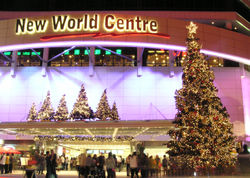
Artificial trees have become increasingly popular, as they are considered more convenient and (if used for several years) less expensive than real trees. Trees come in a number of colours and "species", and some come pre-decorated with lights. At the end of the Christmas season artificial trees can be diassembled and stored compactly.
Artificial trees are sometimes even a necessity in some rented homes (especially apartment flats), due to the potential fire danger from a dried-out real tree, leading to their prohibition by some landlords [citation needed]. They may also be necessary for people who have an allergy to conifers, and are increasingly popular in office settings.
Feather Christmas trees
The first artificial trees were tabletop feather trees, made from green-dyed goose feathers wound onto sticks drilled into a larger one, like the branches on a tree. Originating in Germany in the 19th century to prevent further deforestation, these "minimalist" trees show off small ornaments very well. The first feather trees came to the U.S. in 1913, in the Sears, Roebuck and Company catalog.
Modern Christmas trees
The first modern artificial Christmas trees were produced by companies which made brushes. They were made the same way, using animal hair (mainly pig bristles) and later plastic bristles, dyed pine-green colour, inserted between twisted wires that form the branches. The bases of the branches were then twisted together to form a large branch, which was then inserted by the user into a wooden pole (now metal with plastic rings) for a trunk. Each row of branches is a different size, colour coded at the base with paint or stickers for ease of assembly.
The first trees looked like long-needled pine trees, but later trees use flat PVC sheets to make the needles. Many also have very short brown "needles" wound in with the longer green ones, to imitate the branch itself or the bases that each group of pine (but not other conifer) needles grows from. These trees have become a little more realistic every year, with a few deluxe trees containing multiple branch styles. Many trees now come in "slim" versions, to fit in smaller spaces. Most of the better trees have branches hinged to the pole, though the less-expensive ones generally still come separately. The hinged branched trees just need for the branches to be lowered. But they are a little less compact. Better trees also have more branch tips, the number usually listed on the box.
Around 2003, some trees with moulded plastic branches started selling in the U.S. Now there are also upside down christmas trees. These christmas trees are advertised to "Give you more space for presents".
Designer Christmas trees
The first trees which were not green were the metallic trees of the 1950s and 1960s. They were aluminium-coated paper, meaning that they also posed a great fire hazard if lights were put directly on them (warnings to this effect are still issued with most christmas tree lights). They were instead lit by a spotlight or floodlight, often with a motorised rotating color wheel in front of it. More recent tinsel trees can be used safely with lights.
Other artificial trees which look nothing like a conifer except for the triangular or conical shape, are also used as tabletop decorations, such as a stack of ornaments.
Outdoor Christmas trees
Outdoor branched trees made out of heavy white-enameled steel wires have become more popular on U.S. lawns in the 2000s, along with 1990s spiral ones that hang from a central pole, both styles being lighted with standard miniature lights. These lights are usually white, but often are green, red, red/green, blue/white, blue, or multicoloured, and sometimes with a small controller to fade colours back and forth.
A few hotels and other buildings, both public and private, will string lights up from the roof to the top of a small tower on top of the building, so that at night it appears as a lit Christmas tree, often using green or other coloured lights. Some skyscrapers will tell certain offices to leave their lights on (and others off) at night during December, creating a Christmas tree pattern.
Other gimmicks
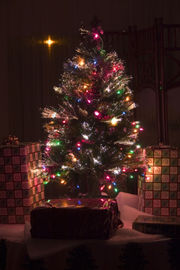
Since the late 1990s, many indoor artificial trees come pre-strung with lights. Some are instead lit partly or completely by fibre optics, with the light in the base, and a rotating colour wheel causing various colours to shimmer across the tree.
In 2005 inverted trees became popular. They were originally sold as decorations for merchants that allowed customers to get closer to ornaments being sold. Customers then wanted to replicate the inverted tree. Retailers also claimed that the trees were popular because they allowed larger presents to be placed beneath the trees.
Past gimmicks include small talking or singing trees, and trees which blow "snow" (actually small styrofoam beads) over themselves, collecting them in a decorative cardboard bin at the bottom and blowing them back up to the top through a tube hidden next to the trunk.
A long-standing and simple gimmick is conifer seedlings sold with cheap decorations attached by soft pipe cleaners. Real potted ones are often sold like this, and artificial ones often come with a "root ball" but only sometimes with decorations.
Environmental issues
There is some debate as to whether artificial or real trees are better for the natural environment. Artificial trees are usually made out of PVC, a toxic material which is often stabilised with lead. Some trees have a warning that dust or leaves from the tree should not be eaten or inhaled. A small amount of real-tree material is used in some artificial trees. For instance, the bark of a real tree can be used to surface an artificial trunk. Polyethylene trees are less toxic, though more expensive, than PVC trees [3].
Artificial trees can be used for many years, but are usually non-recyclable, ending up in landfills. Real trees are used only for a short time, but can be recycled and used as mulch or used to prevent erosion [4]. Real trees also help reduce the amount of carbon dioxide in the atmosphere while growing.
Live trees are typically grown as a crop and replanted in rotation after cutting, often providing suitable habitat for wildlife. In some cases management of Christmas tree crops can result in poor habitat since it involves heavy input of pesticides. Organically grown Christmas trees are available in some markets, and as with many other crops, are widely held to be better for the environment. Dr. Patrick Moore, a co-founder and former president of Greenpeace, writes:
- Whether you choose a cut or growing tree to enjoy this holiday season, I believe that a sensible environmentalist would opt for renewable over non-renewable every time. [5]
Decoration and ornaments
Tinsel and several types of garland or ribbon are commonly used to decorate a Christmas tree. Delicate mould-blown and painted coloured glass Christmas ornaments were a specialty of Czech glass factories from the late 19th century, and have since become a large industry, complete with famous-name designers. Lighting with candles or electric lights (fairy lights) is commonly done, and a tree topper completes the ensemble. Strands of tinsel may be hung in groups from longer branches to simulate icicles, though this trend has gradually fallen off since the late 1970s. Baubles are another extremely common decoration, and usually consist of a fairly small hollow glass or plastic sphere coated with a thin metallic layer to make them reflective, and then with a further coating of a thin pigmented polymer in order to provide colouration.
Individuals' decorations vary wildly, typically being an eclectic mix of family traditions and personal tastes; even a small unattractive ornament, if passed down from a parent or grandparent, may come to carry considerable emotional value and be given pride of place on the tree. Conversely, trees decorated by professional designers for department stores and other institutions will usually have a "theme"; a set of predominant colours, multiple instances of each type of ornament, and larger decorations that may be more complicated to set up correctly.
Many people also decorate outdoor trees with food that birds and other wildlife will enjoy, such as garlands made from unsalted popcorn or cranberries, orange halves, and seed-covered suet cakes.
Christmas Tree mats and skirts
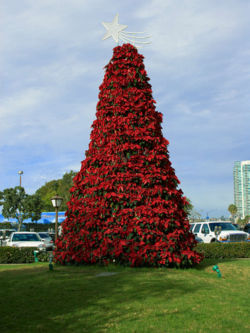
Since candles were used to light trees until electric bulbs came about, a mat (UK) or "skirt" (US) was often placed on the floor below the tree to protect it by catching the dripping candle wax, and also to collect any needles that fall. Even when dripless candles, electric lights and artificial trees have been used, a skirt is still usually used as a decorative feature: among other things, it hides the tree stand, which may be unsightly but which is an important safety feature of home trees. What began as ordinary cloth has now often become much more ornate, some having embroidery or being put together like a quilt.
A nativity scene, model train, or Christmas village may be placed on the mat or skirt. As Christmas presents arrive, they are generally placed underneath the tree on the tree skirt (depending on tradition, all Christmas gifts, or those too large to be hung on the tree, as in "presents on the tree" of the song "I'll Be Home For Christmas").
Generally, the difference between a mat and skirt is simply that a mat is placed under the tree stand, while a skirt is placed over it, having a hole in the middle for the trunk, with a slot cut to the outside edge so that it can be placed around the tree (beneath the branches) easily. A plain mat of fabric or plastic may also be placed under the stand and skirt to protect the floor from scratches or water.
Flocking
In the 1980s some trees were sprayed with fluffy white flocking to simulate snow. Typically it would be sprayed all over the tree from the sides, which produced a look different from real snow, which settles in clumps atop branches. Flocking can be done with a professional sprayer at a tree lot (or the manufacturer if it is artificial), or at home from a spray can, and either can be rather messy. This tradition seems to be limited mostly to the United States.
History

The Christmas tree is often explained as a Christianization of the ancient pagan idea that the evergreen tree represents a celebration of the renewal of life. In Roman mosaics from what is today Tunisia, showing the mythic triumphant return from India of the Greek god of wine and male fertility, Dionysus (dubbed by some modern scholars as a life-death-rebirth deity), the god carries a tapering coniferous tree. Medieval legends, nevertheless, tended to concentrate more on the miraculous "flowering" of trees at Christmas time. A branch of flowering Glastonbury thorn is still sent annually for the Queen's Christmas table in the United Kingdom.

Patron trees (for example, the Irminsul, Thor's Oak and the figurative Yggdrasil) held special significance for the ancient Germanic tribes, appearing throughout historic accounts as sacred symbols and objects. Among early Germanic tribes the Yule tradition was celebrated by sacrificing male animals and slaves by suspending them on the branches of trees. According to Adam of Bremen, in Scandinavia the pagan kings sacrificed nine males of each species at the sacred groves every ninth year. According to one legend, Saint Boniface attempted to introduce the idea of trinity to the pagan tribes using the cone-shaped evergreen trees because of their triangular appearance.
The modern custom, however, although likely related, cannot be proven to be directly descended from pagan tradition. It can be traced to 16th century Germany; Ingeborg Weber-Keller (Marburg professor of European ethnology) identified as the earliest reference a Bremen guild chronicle of 1570 which reports how a small fir was decorated with apples, nuts, dates, pretzels and paper flowers, and erected in the guild-house, for the benefit of the guild members' children, who collected the dainties on Christmas day. Another early reference is from Basel, where the taylor apprentices carried around town a tree decorated with apples and cheese in 1597. The city of Riga, Latvia claims to be home of the first holiday tree, an octagonal plaque in the town square reads "The First New Years Tree in Riga in 1510", in eight different languages. During the 17th century, the custom entered family homes. One Strasbourg priest, Johann Konrad Dannerhauer, complains about the custom as distracting from the word of God. By the early 18th century, the custom had become common in towns of the upper Rhineland, but it had not yet spread to rural areas. Wax candles are attested from the late 18th century. The Christmas tree remained confined to the upper Rhineland for a relatively long time. It was regarded as a Protestant custom by the Catholic majority along the lower Rhine, and was spread there only by Prussian officials who were moved there in the wake of the Congress of Vienna in 1815. In the early 19th century, the custom became popular among the nobility and spread to royal courts as far as Russia. Princess Henrietta von Nassau-Weilburg introduced the Christmas tree to Vienna in 1816, and the custom spread across Austria in the following years. In France, the first Christmas tree was introduced in 1840 by the duchess of Orleans.
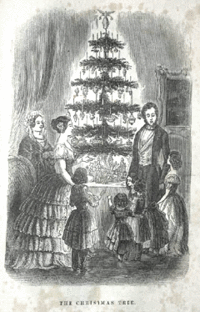
In Britain, the Christmas tree was introduced by King George III's German Queen Charlotte of Mecklenburg-Strelitz, but did not spread much beyond the royal family. Queen Victoria as a child was familiar with the custom, in her journal for Christmas Eve 1832, the delighted 13-year-old Princess wrote: "After dinner...we then went into the drawing-room near the dining-room...There were two large round tables on which were placed two trees hung with lights and sugar ornaments. All the presents being placed round the trees...". After her marriage to her German cousin, Prince Albert, the custom became even more widespread. In 1847, Prince Albert wrote: "I must now seek in the children an echo of what Ernest [his brother] and I were in the old time, of what we felt and thought; and their delight in the Christmas-trees is not less than ours used to be". The generous Prince Albert also presented large numbers of trees to schools and army barracks at Christmas. Images of the royal family with their Christmas tree at Osborne House were illustrated in English magazines, initially as a woodcut in the Illustrated London News of December 1848, and copied in the United States at Christmas 1850 (illustration, left). Such patriotic prints of the British royal family at Christmas celebrations helped popularise the Christmas tree in Britain and among the anglophile American upper class.
There are several cities in the United States which lay claim to that country's first Christmas tree. Windsor Locks, Connecticut claims that a Hessian soldier put up a Christmas tree in 1777 while imprisoned at the Noden-Reed House, thus making it the home of the first Christmas tree in New England. The "First Christmas Tree in America" is also claimed by Easton, Pennsylvania, where German settlers purportedly erected a Christmas tree in 1816.
Many cities, towns, and department stores put up public Christmas trees outdoors for everyone to enjoy, such as the Rich's Great Tree in Atlanta, the Rockefeller Center Christmas Tree in New York City and the large Christmas tree at Victoria Square in Adelaide. During the 1970's and 1980's, the largest Christmas tree in the world was put up every year on the property of The National Enquirer in Lantana, Florida. This tradition grew into one of the most spectacular and celebrated events in the history of south Florida. Unfortunately, this annual affair was discontinued upon the death of the papers founder in the late 1980's.
In some cities festivals are organised around the decoration and display of multiple trees as charity events. In some cases the trees represent special commemorative gifts, such as in Trafalgar Square in London where the City of Oslo presents a tree to the people of London as a token of appreciation for the British support of Norwegian resistance during the Second World War; in Boston where the tree is a gift from the city of Halifax, Nova Scotia, in thanks for rapid deployment of supplies and rescuers to the 1917 ammunition ship explosion that leveled Halifax harbor; and in Newcastle upon Tyne, where the 15 m tall main civic Christmas tree is an annual gift from the city of Bergen, Norway in thanks for the part played by soldiers from Newcastle in liberating Bergen from Nazi occupation.

The United States' National Christmas Tree is lit each year south of the White House in Washington, D.C. Today, the lighting of the National Tree is part of what has become a major holiday event at the White House. President Jimmy Carter only lit the crowning star atop the Tree in 1979 in honor of the Americans being held hostage in Iran; in 1980, the tree was only fully lit for 417 seconds, one second for each day the hostages had been in captivity.
The term Charlie Brown Christmas tree can be used to described any sad-looking, malformed little tree. Some tree buyers intentionally adopt such trees, feeling sympathetic to their plights. The term comes from the appearance of Charlie Brown's Christmas tree in the TV special A Charlie Brown Christmas.
Name controversy
The term holiday tree has, since at least 1990 (and perhaps before), been used by some in the United States and Canada as an effort to be more inclusive, and to reflect the winter holiday season instead of any specific religious holiday. A recent campaign spearheaded by Fox News' contributors Bill O'Reilly and Sean Hannity has resulted in a backlash from some Christian groups and individuals who feel the designation "holiday tree" is part of a so-called war on Christmas.
Usage controversy
Some Christians, albeit a minority, feel that the practice of having "Christmas Trees" is prohibited by the Book of Jeremiah 10:1-5 which says,
- For the customs of the people [are] vain: for [one] cutteth a tree out of the forest, the work of the hands of the workman, with the axe. They deck it with silver and with gold; they fasten it with nails and with hammers, that it move not. They are upright as the palm tree, but speak not: they must needs be borne, because they cannot go. Be not afraid of them; for they cannot do evil, neither also is it in them to do good. KJV.
Interpreting those verses as a ban on Christmas trees may be more common among individuals and Christian denominations that are part of the King-James-Only Movement.
In other English translations of the Bible the verses more explicitly refer to the practice of making idols to be worshipped:
- For the customs of the peoples are worthless; they cut a tree out of the forest, and a craftsman shapes it with his chisel. They adorn it with silver and gold; they fasten it with a hammer and nails so it will not totter. Like a scarecrow in a melon patch, their idols cannot speak; they must be carried because they cannot walk. Do not fear them; they can do no harm nor can they do any good. (emphasis added) NIV
A full study of the passage shows that the people would cut down a tree and work it with a chisel to engrave an image in it. They would also carry it from place to place as an object to be feared and worshipped. The only consistencies with Christmas tree customs seem to be that both are made of wood and both are decorated.
Some Christians, again a minority, feel that since "Christmas Trees" are not biblically ordained, they should not be used. Such individuals and Christian denominations are unlikely to celebrate Christmas at all, for the same reason, such as the United Church of God.
Some churches use the same stripped Christmas tree as a Christian cross at Easter. This is comparable to the Old English poem The Dream of the Rood.
See also
External links
- US National Christmas Tree
- British Royal Family Christmas trees
- Riga, Latvia purported home of the original Christmas Tree
- An iconoclastic look at artificial Christmas trees, at the Gymnosperm Database
- The British Christmas Tree Growers Association homepage
- 1777 Christmas tree in Windsor Locks, CT
Categories: Christmas traditions
Christmas tree